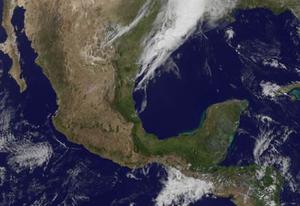DisastersAs fracking activity grows in Mexico, so does the number of fracking-induced tremors
Mexico has the fourth largest amount of recoverable shale gas in the world, with 681 trillion cubic feet. As fracking activity has increased in the state of Nuevo Leon, so have the number of tremors. Between January and mid-April, forty-eight tremors, some reaching a magnitude of roughly 4.3, were recorded across the state of Nuevo Leon, compared to two tremors in the same period last year.

Mexico is experienced more seismic activity as the level of fracking has increased // Source: nasa.gov
The small town of Ramones in the state of Nuevo Leon in northeast Mexico has been experiencing tremors which residents say are unusual in that part of the country. Between January and mid-April, forty-eight tremors, some reaching a magnitude of roughly 4.3, were recorded across the state of Nuevo Leon, compared to two tremors in the same period last year, according to Mexico’s National Seismological Service. Geologists have attributed the tremors to Mexico’s shale gas well operations, which inject a high-pressure mix of water, sand, and chemicals into rocks to collect gas or oil, a process known as fracking.
“The one thing that has changed is the introduction of fracking,” said Ruperto De La Garza, director of the environmental impact consultancy Gestoria Ambiental y de Riesgos. “There is no other explanation.”
Global Post reports that Governor Rodrigo Medina of Nuevo Leon has promised a joint state-federal investigation into the connection between the tremors and the shale wells. The results will be vital to the development of Mexico’s growing shale gas industry and its consequences on the environment.
The U.S. Energy Information Administration notes that Mexico has the fourth largest amount of recoverable shale gas in the world, with 681 trillion cubic feet. As President Enrique Peña Nieto promises jobs and economic growth if Mexico opens its energy sector to global companies, there have been only thirty attempts at hydraulic fracturing in Mexico, mostly in the oil- and gas-rich northeast region.
Fracking has been the subject of debates between environmentalists, who claim it poisons local water sources, and oil and gas companies which argue the method is fundamentally safe. Fracking has been linked to tremors in Oklahoma, Ohio, California, and Texas.
Some supporters of fracking say that the fracking-induced tremors are minor and not deadly. “It is not an earthquake that you typically feel. It is usually just like a truck driving by your house,” said Steve Everly, a spokesman for Energy in Depth, a U.S. research institute funded by oil and gas companies. Everly notes that the tremors are mostly caused by the disposal of water used in fracking, as water is often pumped into the ground when drillers are finished with it. “There are several options for better disposing of the water, or recycling it,” Everly said.
Geologists claim that tremors from fracking are closer to the earth’s surface than major earthquakes, which are caused by the shifting of tectonic plates. “They are very different types of geological movements. There is often a general panic about these [fracking] tremors and that is the wrong thing,” said Aaron Velasco, an earthquake expert at the University of Texas in El Paso. Velasco said that fracking and water disposal could weaken rock structures, making them more vulnerable to the effects of potent quakes.
Activists in Mexico are calling for a suspension of fracking activities until more is known about its consequences. “They say that fracking will bring jobs. But the benefits will only be enjoyed by a few people for a short time,” said Juan Hernandez, a member of the Mexican Alliance Against Fracking in the city of Monterrey. “Meanwhile, the risks are too big. Who knows what damage we are really doing to our environment?”
